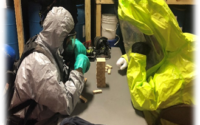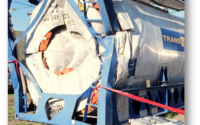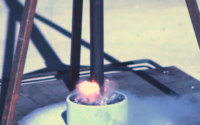Lithium-Ion Battery Toxicity: A Quick Rundown
By Chris Pfaff Fire Captain and prevention
officer at West Pierce Fire & Rescue
NFPA 921, the Fire Investigator’s Guide, explains that smoke is “The airborne solid and liquid particulates and gases evolved when a material undergoes pyrolysis or combustion, together with the quantity of air that is entrained or otherwise mixed into the masses.” This definition is applicable to traditional structure fires, flammable liquid fires, flammable gas fires, and even exposures to lithium-ion battery fires. However, it doesn’t fully capture the complexity of off-gassing from lithium-ion batteries.

When a lithium-ion battery burns, the previous definition fits. But what about when a battery vents without burning? No combustion means no smoke. This falls into the hazmat category of vapor. The big question is: what’s the big deal? Smoke and vapor are both hazardous, right? Absolutely, and it’s crucial to understand what is released from these batteries when they vent and when they burn.
Battery Construction and Terminology
First, a quick reminder about how a lithium-ion battery is constructed and why terminology matters. A lithium-ion battery is not a lithium metal battery. Lithium metal batteries, while dangerous, are typically not as large or prolific as lithium-ion batteries. We commonly encounter lithium metal batteries as button or coin cell batteries. These primary batteries are non-rechargeable and pose a significant toxic and fire threat due to the pure lithium, which is water-reactive. A recent example is the catastrophic fire at a manufacturing facility in South Korea on June 24th, where 23 workers tragically lost their lives.

In contrast, lithium-ion batteries do not contain pure lithium, which means the lithium in these rechargeable batteries is not water-reactive. The lithium is chemically bonded in the “black mass” that coats the copper anode and aluminum cathode of the battery and within the electrolyte, lithium hexafluorophosphate.
For those paying close attention, lithium hexafluorophosphate sounds a bit alarming, and rightfully so. For a lithium-ion battery to function, it requires this electrolyte to transfer the lithium ions, hence its name. However, salts are solids, and if the electrolyte were solid, it would be a solid-state battery. To make it a liquid, it is mixed with a liquid containing multiple volatile organic compounds, including hydrocarbons and other exotic chemicals. This is where these batteries have created the problems we are discussing.
Released Gases and Products of Combustion

With a basic understanding of lithium-ion battery construction, we can identify some of the released gases and possible products of combustion. There are countless others, but this article focuses on the significant groups. When batteries vent before igniting, there are two plumes: one heavy and one light. The lighter compounds typically (but not always) include hydrogen, hydrogen fluoride, ethane, carbon monoxide, hydrogen cyanide, and various other products. The heavier-than-air vapors consist of serious toxins, including sulfur dioxide, many flammable volatile organic compounds, and metal oxides such as cobalt, manganese, lead, antimony, nickel, and strontium.
Depending on the energy involved and the chemical makeup, these batteries may quickly go into full thermal runaway. When these fires burn, many hazardous toxins are converted into more traditional forms of combustion. This is one reason why the tactic of letting the fire burn has gained traction. However, carbon monoxide and hydrogen cyanide still exist, as do the metal nanoparticles.
Considerations for Firefighting
Depending on the fire’s location, nature of exposures, public perception, and other factors, including the ability to extinguish the fire, it may be better to extinguish or at least suppress the flames. Our goal is always to save lives. We need to step in and do our jobs while understanding the risks involved. The toxins from these fires are much worse than normal fire smoke.
| Chemical | IDLH | PEL/REL | Est. Amount Released 20kWh battery |
| Carbon Monoxide | 1200PPM | 50 ppm / 35 ppm | 1300-4950ppm |
| Hydrogen Cyanide | 50PPM | 10 ppm / 4.7 ppm | |
| Hydrogen Fluoride | 30PPM | 3 ppm/ 3 ppm | 30-1250ppm |
| Cobalt | 20mg/m3 | 0.1mg/m3 / 0.05mg/m3 | 1700-2700mg/m3 |
| Nickel | 2000 mg/m3 | 1mg/m3 / 0.015mg/m3 | |
| Manganese | 500 mg/m3 | 5mg/m3 / 1 mg/m3 |
Chemical | IDLH | PEL/REL | Est. Amount Released (20kWh battery)
Willstrand, O., Bisschop, R., Blomqvist, P., Temple, A., & Anderson, J. (2020). <i>Toxic Gases from Fire in Electric Vehicles</i>. Retrieved from https://urn.kb.se/resolve?urn=urn:nbn:se:ri:diva-52000
Understanding that these products release significantly high amounts of severe toxins should give us pause. But we must remember the fire service’s ultimate goal: life safety. It is our job as hazmat technicians to inform our agencies and provide guidance. If we overreact, the message will not be heard, and injuries will occur. Conversely, if we treat this as a normal fire, we could get hurt from the toxic vapors produced.
Response Strategies
If there are victims in a lithium-ion battery event, such as an EV/hybrid fire or structure fire, we need to be aggressive, smart, and deploy fast tactics to give victims the best chance of survival. If there is no rescue component or if we are dealing with a reignition event or overpacking, our tactics need to change. This article isn’t about providing tactics but rather about informing us of the hazards responders face when dealing with batteries in thermal runaway.
Consider these two events. Last year in Eastern Washington, a Tesla left a highway at approximately 80 MPH. The ensuing fire was so intense that nearly all battery cells and the victim were consumed. This was partially due to the slow response of the volunteer department and the lack of a continuous water supply. The decision to let the fire burn was the only option available. Post-soil metal contamination found little environmental contamination. There are no study results on contamination of personnel or PPE, so draw your own conclusions.
Earlier this year, in Western Washington, a nearly identical event occurred, still under research. In this case, a Tesla in a high-speed accident was responded to quickly by a career fire department with a continuous water supply. The fire was knocked down, but the subsequent cleanup was more challenging. Soil contamination of heavy metal particulates was “astronomical” compared to background readings. No PPE or personnel exposure figures were obtained, but there were reports of responders experiencing headaches and respiratory issues weeks after the incident.
Health Impacts
As hazmat technicians, we must undergo annual physicals, including a heavy metal blood draw. This isn’t because we respond to multiple smelter accidents; it’s due to the nature of metals in our body and our difficulty excreting them. Metals stay in our system. Consider the focus on lead exposure and mercury poisoning. The same applies to all metals found in lithium-ion batteries.
Between traditional hazardous gases and metal nanoparticles, much is still unknown about the combustion and off-gassing of these batteries. Later this summer, TEEX, in conjunction with Southwest Research Institute, will release metal contamination testing to see if CO2 extraction can remove contaminants. UCLA has been working with the San Diego Fire Department on general testing, and FSRI has partnered with North Carolina State University for more testing.
Conclusion
In the meantime, check out some of the most recent international research. A recent article, “Review of gas emissions from lithium-ion battery thermal runaway failure—Considering toxic and flammable compounds,” is available online. Below is a snippet from my friend Todd Smith (CFI). Many articles are found in this attached link on health impacts to responding firefighters.




